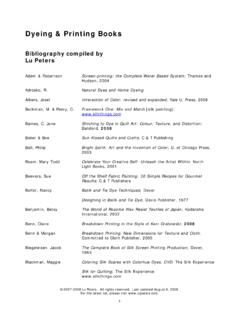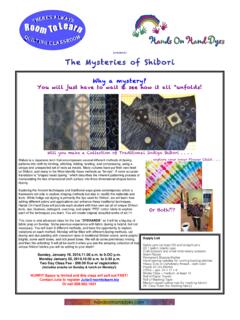Transcription of The Shibori Process - Craft Mark
1 The Stitch-Resist Shibori Process 1. Introduction 2. Regions 3. Tools/Raw Materials 4. The Process Design Stitching Tightening dyeing 5. An Example of Two-color Shibori Process 6. Identifying Authentic Shibori 7. Other Techniques 1. Introduction Shibori comes from the Japanese word shiboru, meaning to wring, squeeze or press . It refers to a variety of ways of embellishing textiles by shaping cloth and securing it before dyeing . Although Shibori is used to designate a particular group of resist-dyed textiles, the word emphasizes the action performed on cloth, the Process of manipulating fabric . Rather than treating cloth as a two-dimensional surface, with Shibori it is given a three-dimensional form by folding, crumpling, stitching, plaiting, or plucking and twisting.
2 Cloth shaped by these methods is secured in a number of ways, such as binding and knotting. It is the pliancy of textiles and the potential for creating a multitude of shape-resisted designs that the Japanese concept of Shibori recognizes and explores. The Shibori family of techniques includes numerous resist processes practiced throughout the world. Here, we will map out the Process as it is done in India. In most languages Shibori has no term that encompasses all the various techniques; nor is there English terminology for individual methods, which often have been incorrectly lumped together as tie-and-dye . Three terms for separate Shibori methods have come into international usage: plangi, a Malay-lndonesian word for the Process of gathering and binding cloth; bandhini, an Indian term for the same Process ; and tritik, a Malay-lndonesian word for stitch-resist.
3 However, these three terms represent only two of the major Shibori techniques. The special characteristic of Shibori resist is a soft- or blurry-edged pattern. The effect is quite different from the sharp-edged resist obtained with stencil, paste and wax. With Shibori the dyer works in concert with the materials, not in an effort to overcome their limitations, but to allow them full expression. And an element of the unexpected is always present. In India Shibori was first introduced by literature Nobel laureate Rabindranath Tagore, famed for his interest in reviving and reinventing the traditional arts and crafts of the country apart from his expertise in Bengali literature.
4 2. Regions Shibori is practiced in the urban villages of Delhi, Craft clusters of Rajasthan and Bhuj in Gujarat Most artisans use the rope-tied technique of Shibori wherein a rope is tied to a bundle of fabric . Only the area that does not have the rope gets colored, while parts under it resists. This method of tie-and-dye is a coarser variant of the Shibori Process that has been explained above. 3. Tools Needle, dyeing pots 4. Raw Material Thread, unbleached cotton cloth and colored natural dyes. 5. The Process The Shibori Process has four steps, consisting of design, stitching, tightening and finally dying. Design As with any creative Process , Shibori begins with the conceptualization of the design.
5 Though there are certain linear and non-linear patterns that form the basic motif of a Shibori design, the Process does provide the designer with an unlimited array of combinations within the basic framework. After the design has been structured on paper or on the computer, it is transferred/copied on to a thin sheet of plastic. The plastic sheet is then passed through a sewing machine along the outline of the design and is stitched without thread. A stencil made in this manner contains tiny holes along the design. Laying the stencil on natural unbleached cloth, a duster dipped in kerosene and silver solution is pressed along it.
6 The solution seeps through the tiny holes marking the design on the cloth. In the kerosene and silver solution used, the former acts as a binder. The kerosene evaporates from the cloth, while the silver stain can be easily removed by washing the cloth. Stitching The next level of the Process is stitching. With the marking done on the fabric , a running stitch (manually with needle and thread) is made along the design. Photograph process1: The design from the plastic sheet (stencil) being transferred on to the cloth. Photograph product1: After the natural fabric has been transcribed with the design. At the two ends of the thread a small piece of cloth is attached that allow the thread to be pulled from both the ends, thus crushing the fabric .
7 (Photograph Process 2: An artisan stitches the design.) (Photograph product 2: The fabric after the stitch has been undertaken.) Tightening The Shibori Process now progresses to the most important part the tightening. Here, two people are required, one holding the cloth, the other pulling the two ends of the thread in the opposite direction. The cloth along the thread gets compressed and a knot is then made to bind the cloth and not allow the color to seep into it (the area compressed by the knot) at the time of dyeing . The right amount of pressure is required to tie the knot as a lose loop that can allow the color to percolate into the knot where the color is not required.
8 It is because the entire area on the fabric gets colored other than spot within the knot that the Process is referred to as a stitch-resist dying technique . (Photograph Process 3: Two persons tightening the thread. The one on the right holds the stitched fabric while the other pulls the threads in the opposite direction.) (Photograph product 3: The cloth after the Shibori tightening, ready for dyeing .) dyeing With the tightening done, the fabric is soaked in a mild soap solution for some time. Thereafter, it is dipped in a bath for dyeing . For preparing the bath, the material to liquid ratio (MLR) should be maintained in the region of 1:20.
9 For example, 1 kg of fabric or yarn requires 20 l of water. Similarly, for the concentration of color explained below, a 5 per cent description refers to 50 g of color (or any other chemical) to be dissolved in 20 l of water for 1 kg of fabric or yarn. Apart from indigo, all the other colors are hot processes , that is, they require water to be mildly heated while the dyeing Process is on. For all the colors described below, the cloth/yarn is to be kept in the bath for 45 minutes In natural dyeing , in order to increase the absorption of color as well as for fastness, the concentration of dye should be increased incrementally.
10 For example, once the 5 per cent indigo bath is ready and the fabric /yarn has been immersed in it, if a darker shade is required then more indigo should be added slowly (1-2 per cent) till the desired shade is achieved. The Process of natural dyeing for a few popular colors of Shibori is explained. For indigo, the dry cake is grinded into fine powder and mixed with water. Sodium hydroxide and sodium hydrosulfide are added to the bath. Indigo powder, sodium hydroxide and sodium hydrosulfide are dissolved in the ratio of 1:1:4. The latter two are required to introduce hydrogen into the solution so that the necessary chemical reduction can take place (chemical reduction can happen either by the introduction of hydrogen or by the extraction of oxygen; in this Process hydrogen is being introduced).









